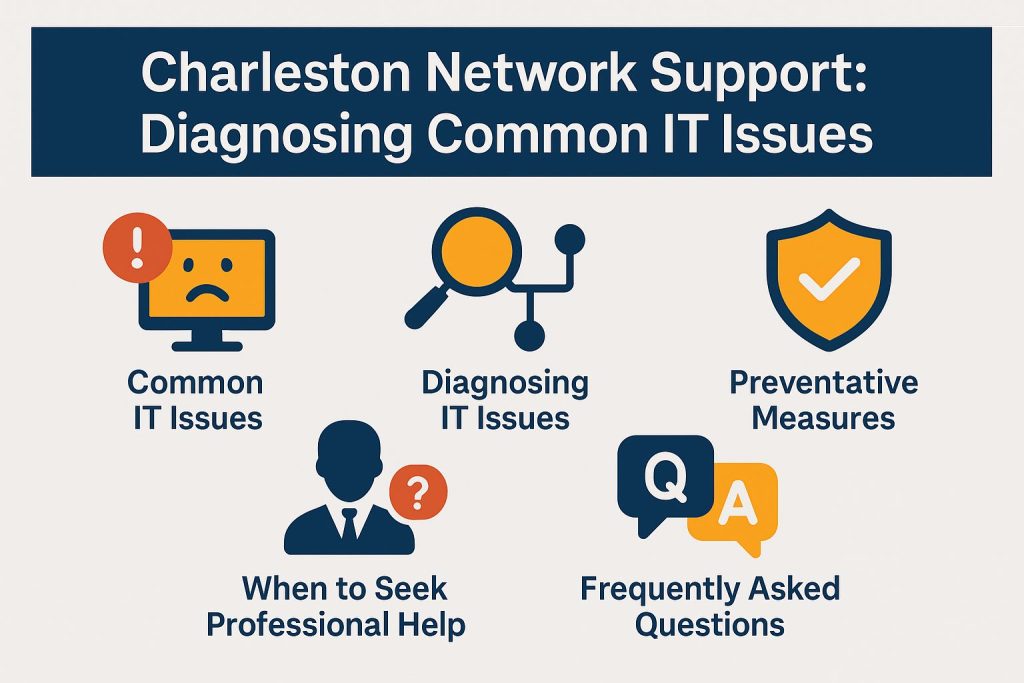How to Avoid Common IT Mistakes in a Growing Business

Growing companies face challenges. They often struggle with IT systems and resource management. Common mistakes cause setbacks. Recognizing these pitfalls is the first step to success. This article looks at common IT errors and their consequences. It provides strategies to avoid these mistakes, including change management practices.
It emphasizes the importance of careful planning, the necessity of investing in robust infrastructure, and the advantages of training employees.
Readers are encouraged to explore effective IT solutions that can drive their business forward, focusing on strategic planning and innovation.
Common IT Mistakes in Growing Businesses
Understanding common IT mistakes is essential for business success. Numerous companies encounter challenges related to technology management that can impede their growth and result in significant repercussions.
These errors frequently arise from a lack of a well-defined IT strategy, inadequate employee training, and insufficient budget allocation for technology investments. As organizations scale, they must address issues such as cybersecurity threats, ineffective data backup practices, and the failure to maintain robust IT infrastructure.
This section will examine these prevalent errors and their implications for overall business performance. Related insight: Small Business IT Services in Charleston provide tailored solutions to help mitigate these common IT challenges.
Overview of IT Mistakes and Their Impact
IT mistakes can lead to serious consequences for businesses, especially in cybersecurity and compliance. When organizations do not implement adequate IT policies, they expose themselves to risks such as data breaches and loss of customer trust, which can severely affect their growth trajectory.
Neglecting IT practices, like software updates and performance monitoring, can harm data security and efficiency, affecting profits.
Statistics indicate that 60% of small businesses close their doors within six months of a cyber attack, emphasizing the critical need for a solid IT infrastructure. A study conducted by IBM found that the average cost of a data breach is approximately $4.35 million, a financial burden that many organizations struggle to withstand.
High-profile case studies, such as the Equifax data breach in 2017, underscore the catastrophic consequences of compliance failures, as the company faced severe legal repercussions and significant reputational damage.
Organizations must prioritize IT audits and strong technical support to navigate these challenges. Implementing risk mitigation strategies can significantly decrease the likelihood of future incidents, thereby ensuring a secure and compliant business environment.
Key Strategies for Avoiding IT Mistakes
To successfully navigate the complexities of technology management and avoid common IT mistakes, businesses must adopt key strategies that promote proactive measures.
A comprehensive IT strategy helps identify risks and find solutions to improve operational efficiency.
Additionally, prioritizing employee training on best practices for network security and data management is crucial in mitigating risks associated with phishing attacks and technical debt.
Furthermore, effective budget allocation is vital in ensuring the scalability and sustainability of IT initiatives, enabling businesses to adapt to evolving technology trends.
Importance of Planning and Communication
Planning and communication are key to preventing IT mistakes and executing an IT strategy successfully. When businesses prioritize clear communication tools among team members, they foster collaboration and enhance project management efforts, which leads to improved decision-making processes.
Establishing a culture of knowledge sharing and regular updates can significantly mitigate risks associated with technical debt and operational inefficiencies.
In this dynamic landscape, adopting collaboration software is crucial for optimizing workflows and maintaining transparency among team members. By leveraging these tools, organizations can better align their strategic goals, streamline tasks, and facilitate real-time feedback. As a result, such structured approaches lay the groundwork for successful digital transformation.
Effective planning and modern communication technologies improve project management. This increases the chances of achieving desired outcomes.
Investing in Proper IT Infrastructure and Security
.jpg_01.jpeg)
Investing in IT infrastructure and security is crucial. It helps businesses avoid common IT mistakes. A robust IT infrastructure ensures that systems can support the organization’s growth, while the implementation of stringent network security protocols protects against potential threats, enabling effective risk management and compliance.
Reliable data backup and disaster recovery plans ensure compliance and protect customer data from unforeseen incidents.
To enhance resilience, assess system vulnerabilities. This helps identify weak points and prioritize areas needing attention. This proactive approach reduces risks. It also supports investments in cloud storage for scalable resources and better accessibility.
Using modern hardware improves network performance and data management efficiency. It helps IT teams streamline infrastructure tasks effectively.
Focusing on these strategies helps businesses create a secure and agile environment. This prepares them to navigate modern technology complexities, bolstering their digital transformation initiatives. Curious about how to build a cybersecurity strategy for small teams? Our guide outlines essential steps to protect your business effectively.
Regular Maintenance and Updates
Regular maintenance and timely software updates prevent IT errors and ensure optimal system performance. Organizations must develop maintenance plans that enable consistent monitoring and upgrading of IT systems to address vulnerabilities and enhance overall functionality.
Neglecting these practices can lead to technical debt, more downtime, and less efficiency in business processes.
Structured maintenance schedules help organizations find issues before they become major problems. This structured approach should be complemented by comprehensive IT audits that reveal existing weaknesses within the system.
Moreover, training employees on new software and system upgrades is crucial. This training fosters a culture of responsiveness and adaptability. When users understand their systems, they can use the latest features effectively. This leads to higher productivity and fewer errors.
Prioritizing these elements significantly improves an organization’s IT environment.
Effective IT Solutions for Growing Businesses
Strategic IT governance and solutions architecture align business processes with technology advancements.
Effective IT solutions support business growth and enhance operational efficiency.
Leveraging cloud computing and outsourcing IT services helps organizations access the latest technology and minimize in-house costs. If you’re interested, our Charleston Business Guide to cloud solutions provides valuable insights into optimizing these strategies.
Furthermore, adopting productivity tools improves user experience and remote work. This enhances collaboration and drives business growth.
Cloud Computing and Outsourcing IT Services
Cloud computing and outsourcing are vital strategies for businesses. They enhance technical support and achieve scalability in IT infrastructure. By leveraging cloud solutions, organizations can optimize resource management, reduce hardware costs, and streamline operations. Outsourcing IT functions allows businesses to focus on core competencies while accessing specialized expertise and advanced technology.
These strategies save costs and provide flexibility. They allow businesses to easily scale operations in response to market changes. With cloud computing, companies can quickly allocate or deallocate resources based on current needs. This avoids substantial costs of traditional IT setups.
Improved disaster recovery in cloud services keeps critical data secure and accessible. This minimizes downtime during emergencies.
Outsourcing IT helps organizations manage technical debt. This approach improves resource allocation and governance practices. It also streamlines compliance and boosts efficiency.
Training and Educating Employees on IT Best Practices
.jpg_10.jpeg)
Training employees on IT best practices is crucial. It fosters cybersecurity awareness and improves operational efficiency. By implementing robust user training programs, businesses can equip their workforce with skills to handle threats like phishing and data breaches. Ongoing education on productivity tools enhances user experience and encourages innovation in security and software development.
To create a comprehensive training framework, organizations should incorporate various components, including:
- Interactive workshops for team collaboration and skill development
- Informative seminars focused on IT strategy and stakeholder engagement
- Accessible online resources including productivity software and digital tools
Workshops offer hands-on experiences. They help employees apply best practices and boost productivity. Seminars led by industry experts offer valuable insights into IT compliance and risk assessment, emphasizing the critical importance of risk mitigation strategies.
Additionally, online resources such as webinars and e-learning modules facilitate continuous knowledge sharing, ensuring that employees remain informed about evolving cyber threats and compliance requirements. Blending these methods helps businesses build a resilient workforce. This workforce can maintain security, efficiency, and continuity in a complex digital world.
Frequently Asked Questions
What are some common IT mistakes and IT governance challenges that growing businesses make?
Common IT mistakes include: no proper backup system, not updating software, neglecting hardware upgrades, lacking a disaster recovery plan, and improperly securing sensitive data. These mistakes impact data privacy.
How can I avoid these IT mistakes in my growing business?
To avoid IT mistakes, invest in a reliable backup system. Regularly update software and security protocols, create a disaster recovery plan, and implement strong data security measures.
What can happen if I don’t address these IT mistakes in my growing business?
.jpg_11.jpeg)
If not addressed, these IT mistakes can cause data loss, system downtime, tech debt, security breaches, and legal issues. This affects efficiency and can lead to productivity loss, financial losses, and damage to your business reputation.
What are the benefits of avoiding common IT mistakes in a growing business?
Avoiding IT mistakes ensures the security and stability of your technology. It minimizes data loss, increases productivity, and protects your reputation.
How often should I review and update my IT systems and protocols?
Review and update your IT systems at least once a year. Consider system audits for better results.
Is it worth investing in professional IT support for my growing business?
Yes, investing in professional IT support helps you avoid mistakes and ensures smooth technology operation.




